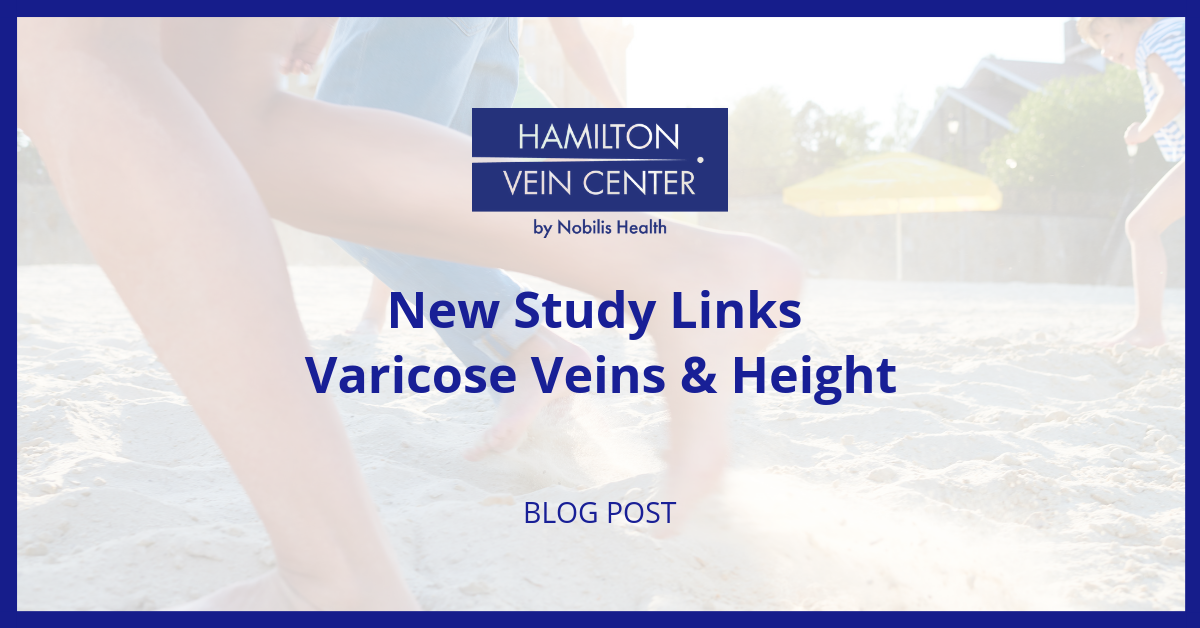New Study Links Varicose Veins & Height

A Growing Problem
If you suffer from varicose veins, you’re far from alone. Approximately 20 percent of Americans suffer from this condition, with rates higher in women and older people. [1] There are many factors associated with how these develop, including obesity, smoking, and others, as well as other endemic conditions. Recently, however, our understanding of varicose veins took a step forward as researchers found association between this disease and height.
According to a team of Stanford University researchers, the taller you are, the more likely it is that you develop varicose veins. [2] How did they get to these results? What are the implications of these findings? Let’s take a closer look.
A Wide Pool
The study, under the direction of Drs. Nicholas Leeper and Erik Ingelsson, sought to gain a deeper understanding of both genetic and environmental risk factors for varicose veins. In this effort, the researchers assessed data from 493,519 individuals in the UK Biobank, a vast database of medical information. [3] Since height varies a great deal, they also were able to determine what sort of relationship this attribute has with the formation of varicose veins.
The beauty of the design here is the sheer scope of their data pool; this allowed Drs. Leeper and Ingelsson and their colleagues to gain a broader sense of what leads to this condition. The work was systematic and thorough, relying on statistical analysis—and as we’ll see “machine learning”—to wade through the data.
Old Associations & New
Most of what the researchers found confirmed previous findings: that older age, sex, obesity, pregnancy, and a history of deep vein thrombosis are all significant risk factors for varicose veins. However, they also found that height is another strong determinant. Essentially, the results made clear that taller people are more likely to develop this condition, and the association was so strong they called it a “a causal risk factor for disease.” [3] This was the first time such a robust connection was observed.
Since this study also entailed an analysis of genetics and varicose veins, Drs. Leeper and Ingelsson were able to get some insight into the actual ways that genes are involved. Among the findings was an association between diseased veins and genes that determine vascular, limb, and bone development. [3] This deepened our understanding of how individual DNA make-up plays a role when it comes to this disease. Commenting on this work, Dr. Ingelsson told Stanford Medicine News Center, “Our results strongly suggest height is a cause, not just a correlated factor, but an underlying mechanism leading to varicose veins.” [2]
New Understanding & New Approaches
While the research was primarily intended to confirm what was already known about varicose veins as well as genetic and environmental factors, the height results were unexpected. Not only that, the focus on specific genes allowed the researchers to get at the underlying pathways of how this works.
Beyond the results themselves, the approach taken by these researchers was also novel. Typical research involves first formulating a hypothesis—what’s believed to be the case—that needs to be tested. In this case, however, Drs. Ingelsson and Leeper employed a “machine-learning algorithm” to analyze the data without an initial bias, and then point to trends that it is unearthing. [3] Seeing that the algorithm had flagged height as related, they focused on that issue and ran more tests.
In many ways, this is a radical step forward. “These methods represent new ways of thinking about research,” Ingelsson noted. “You go in without a hypothesis about a specific biological mechanism and scan for something new…you turn the machine loose on it.” [2] Technology and science, basically, are working hand in hand in ways that would have been unimaginable years ago.
Brighter Outcomes
While it will require more work directed at application, research like this is promising because it points to even more ways to take on varicose veins. By fully appreciating the underlying mechanics of this condition—as well as understanding all of the risk factors that lead to it—treatments will only become more effective. In the same way that medical interventions for this disease today wholly outclass previous methods, you can rest assured that things are going to get even better in the future.
If you’re suffering with varicose veins, the team at Hamilton Vein Center can help. These Texas-based experts employ the latest in highly-effective minimally-invasive approaches to this difficult condition. Suffer in silence no more and call one of their Patient Care Managers at (281) 565-0033 for the Houston office, Austin at (512) 710-1114, or San Antonio at (210) 405-4707 today!
References
- Varicose Veins: Overview”. 2016. Institute For Quality And Efficiency In Health Care (Iqwig). https://www.ncbi.nlm.nih.gov/pubmedhealth
- “Height May Be Risk Factor For Varicose Veins”. 2018. News Center. Accessed October 14 2018. http://med.stanford.edu/news/all-news/2018/09/height-may-be-risk-factor-for-varicose-veins.html.
- Ingelsson, Erik, Nicholas J. Leeper, Daniela Zanetti, Stefan Gustafsson, Daniel Lindholm, Eri Fukaya, and Alyssa M. Florence. 2018. “Clinical And Genetic Determinants Of Varicose Veins Prospective, Community-Based Study Of ≈500000 Individuals”. Ahajournals.Org. https://www.ahajournals.org/doi/pdf/10.1161/CIRCULATIONAHA.118.035584.